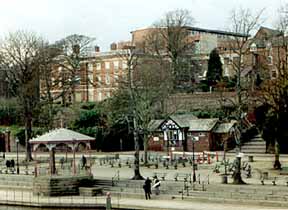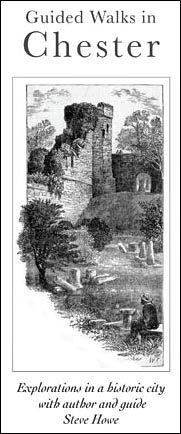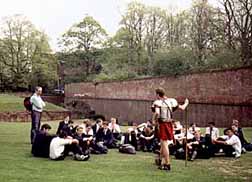 In March 2001, we learned at last who would be responsible for producing the long-promised conservation plan to decide the future Chester’s Roman amphitheatre and its surroundings. Against stiff competition from, among others, Gifford’s and the council’s own Chester Archaeology, the commission was awarded to historic buildings architects and consultants Donald Insall and Associates in partnership with eminent archaeologists Dr David Mason (covering the amphitheatre) and Dr James Anderson (covering Dee House). The study is estimated to be costing around £30,000. In March 2001, we learned at last who would be responsible for producing the long-promised conservation plan to decide the future Chester’s Roman amphitheatre and its surroundings. Against stiff competition from, among others, Gifford’s and the council’s own Chester Archaeology, the commission was awarded to historic buildings architects and consultants Donald Insall and Associates in partnership with eminent archaeologists Dr David Mason (covering the amphitheatre) and Dr James Anderson (covering Dee House). The study is estimated to be costing around £30,000.
Founder Donald W Insall (from 2010 Sir Donald Insall: left) is considered a pioneer of building conservation in Chester. His landmark work, Chester: A Study in Conservation, appeared in 1968, at a time when the ancient city was going through enormous changes- notably the construction of the Inner Ring Road, the Grosvenor Precinct and the Forum- and was the inspiration for similar schemes in historic cities throughout the country.
His consultancy with the City Council continued for over another twenty years and the publication of a second major review, Conservation in Chester, in 1986. He wrote that "Conservation is not about living in the past; it is the creation of an environment within which our architectural heritage can survive for future generations".
Whether he was able to forsee a time when this would include their survival only by being buried beneath courthouses is unclear, however...
We should remind you at this point of what Insall and his partners have had to say about Dee House and the amphitheatre over the years:
• "Very little of the original merit of the Georgian house remains; it is hard to imagine any viable new use for its small rooms"
• "There should be no new building on or close to the amphitheatre, and the long term likelihood is that it will be totally excavated and exposed. This would involve some demolition of the Convent, including the listed section"
• "This exciting possibility would provide Chester with another major attraction; the centre-piece of an amenity area that has been protected and enhanced for the benefit of the citizens and their visitors".

His 1986 report concluded that "we recommend the following objectives and action: (F.4.3) Fully support the excavation of the southern part of the Roman amphitheatre and the development of appropriate interpretative facilities".
Right: March 2001: McLean's courthouse approaches completion and dominates the skyline above the Old Bishop's Palace, Groves and River Dee
Mr Insall was made a Freeman of the City of Chester in April 2000 and in January 2001, was awarded the Europa Nosta Medal of Honour for "exemplary work in the field of heritage conservation". His company set up an office in Foregate Street, Chester in 1998. He will not be personally involved in the conservation plan; assistance is being given by architect Rob Fraser and senior associate Tony Barton to prepare the study being undertaken by Drs Mason and Anderson.
We well recall Dr Mason adressing a packed public meeting at the Town Hall in May 2000, called by the Chester Amphitheatre Trust, during which he spoke movingly of the callous trashing of the great Roman bath houses and the mysterious 'elliptical building'- unique in the Roman World- in the 1960s and 70s during the construction of the Grosvenor Precinct and Forum, illustrated with some heart-rending slides of the bulldozers at their destructive work. A time, as he put it elsewhere, when Cestrians "watched their precious Roman heritage being smashed up and carted away on the backs of lorries" Roman Chester: City of the Eagles, p 20.
There are those who would have you believe differently; Chester Amphitheatre: From Gladiators to Gardens, written by Stewart Ainsworth (of TV's Time Team fame) and Tony Wilmott, which was published in 2005 by Chester City Council and English Heritage, disingenuously informs us that the elliptical building is "now beneath the Town Hall".
 The trio are said to be keen to obtain the input of all interested groups such as Chester City Council, English Heritage, the Chester Amphitheatre Trust and David McLean Developments- in addition to those of concerned members of the public. By taking into account such divergent aspirations as those represented by McLean's 'offices and wine bars' concept on one hand to the Chester Amphitheatre Trust's (not to mention the public's) call for a complete excavation together with the provision of quality interpretative facilities, they would seem to have a difficult balancing act before them. The trio are said to be keen to obtain the input of all interested groups such as Chester City Council, English Heritage, the Chester Amphitheatre Trust and David McLean Developments- in addition to those of concerned members of the public. By taking into account such divergent aspirations as those represented by McLean's 'offices and wine bars' concept on one hand to the Chester Amphitheatre Trust's (not to mention the public's) call for a complete excavation together with the provision of quality interpretative facilities, they would seem to have a difficult balancing act before them.
Tony Barton has said of the aims of the study, "it is an assessment of the importance of the site and will provide a framework against which decisions about its future can be taken... we will be giving the parameters and as much guidance as we can".
Chester City Council will, of course, be under no compulsion to agree with or accept any of the findings within Insall's study, nor to act upon any of its recommendations. As we have seen, numerous previous reports and recommendations about the Chester amphitheatre have been published over the last seventy or so y ears, virtually unanimous in their call for a quality full excavation, and still a private interest was allowed to erect their office block and car park on top of a significant proportion of the monument- and continues to aspire to the commercial development of Dee House and much of the rest of the site... ears, virtually unanimous in their call for a quality full excavation, and still a private interest was allowed to erect their office block and car park on top of a significant proportion of the monument- and continues to aspire to the commercial development of Dee House and much of the rest of the site...
Right: The County courthouse approaching completion in May 2001. Note the white curved line in the car park indicating the outer wall of the amphitheatre lying beneath.
You may be interested to learn that Insall's is by no means the only amphitheatre study in progress. A team of City Council officers are also currently busy preparing a 'development brief' for the entire area, encompassing the amphitheatre, River Dee, Roman Gardens, the Newgate and City Walls, St. John's Church and Grosvenor Park and a £10,000 'tourism study', jointly funded by the City Council and Chester Amphitheatre Trust, has recently (May 2001) been commissioned from York-based company Past Forward. They are specialists in the presentation, interpretation and marketing of heritage sites and assisted CAT back in June 2000 by providing guideline figures for visitor numbers and estimates of potential revenue that could be generated from a suitable visitor centre. Those figures have always been understood to be arbitrary and the main purpose of this tourism study will be to come up with hard numbers that can be relied upon to ascertain if there is real potential for for a visitor centre generating sufficient income to fund excavation of the site.
The findings of all three groups will, we are told, be used in arriving at an eventual 'definitive' plan-of-action.
Based upon performance to date, what the council team are likely to come up with is currently anyone's guess. A hard look at the 'development possibilities' offered by the area which includes the site currently occupied by the cheerless Chester Visitor Centre across the road from the amphitheatre would seem to be on the cards, and, in addition, may we hope that some attempt will be made to adress the inevitably-worsening traffic conditions that will be brought about by the incongruous presence of a major court of law in the midst of what could have been a peaceful, traffic-free and history-rich conservation area?
We can only hope that all parties will manage to arrive at last at some sort of agreement to give Chester the amphitheatre it deserves- and demands- or the whole thing may once again, as with all those learned works of the past, have been a complete waste of everybody's time and make it even more likely that the self-serving plans of commercial developers will once again be allowed to prevail. The last thing the city needs- especially here- is more wine bars and office blocks. The people of Chester have seen and heard it all before and are in no mood for further half-truths and prevarication.
Whatever the future holds, we wish all parties well in their labours and very much look forward to reading their final reports.
In March 2001, Chester City Council, as part of their 'Who Decides?' consultation exercise, regarding proposed changes in how the council organised itself in the future, enlisted the services of Liverpool-based Dialogue Market Research Ltd to conduct a survey of residents views.
Admittedly, for such an important issue, the sample taken was absurdly small- only 2500 questionnaires went out of which less than 600 were returned- but the ensuing report, JN 1028, dated 9th March 2001, made for interesting reading indeed; the section dealing with planning issues was a telling commentary upon the council's attitude to the public. On the subject of the Chester amphitheatre, for example:
 "Most group respondents are aware of the amphitheatre project and comments suggest that most are against the council's plan for the amphitheatre, stating that it would go against the tourism policy. The issue of the amphitheatre is cited as an example where the council has not listened to public opinion". "Most group respondents are aware of the amphitheatre project and comments suggest that most are against the council's plan for the amphitheatre, stating that it would go against the tourism policy. The issue of the amphitheatre is cited as an example where the council has not listened to public opinion".
The report cost Chester's taxpayers £25,000 and, surprise surprise, little has been heard of it since.
Left: May 2001. A Legionnaire gives a pep talk to one of the many school groups who regularly visit the Chester amphitheatre.
In May 2001, Malpas-based PR consultant Penny Whitehouse made the interesting suggestion that Dee House should be transformed into an art gallery. She said that more professional artists live and work in Cheshire than any other part of the country but that the exhibition scene, based upon "a cluster of private galleries in Watergate Street" is "rather dull...there is nothing in Chester to excite the senses".
Penny says Dee House is the preferred location for her City Gallery Project- but, given the history of the site to date, and likely stiff competition for the 'wine bars and offices' brigade, is realistic enough to also be looking at other sites in the city, such as vacant buildings at the Castle and Blacon Arts Centre (too late- it was recently demolished to make way for a police station). "I simply want to make something happen here and I'm going to give it my best shot, but I can't do it on my own. I want to hear from people about the idea of a gallery and possible locations".
Go on to part IX of the Chester Amphitheatre story - or visit the magnificent church of St. John the Baptist |
 In March 2001, we learned at last who would be responsible for producing the long-promised conservation plan to decide the future Chester’s Roman amphitheatre and its surroundings. Against stiff competition from, among others, Gifford’s and the council’s own Chester Archaeology, the commission was awarded to historic buildings architects and consultants Donald Insall and Associates in partnership with eminent archaeologists Dr David Mason (covering the amphitheatre) and Dr James Anderson (covering Dee House). The study is estimated to be costing around £30,000.
In March 2001, we learned at last who would be responsible for producing the long-promised conservation plan to decide the future Chester’s Roman amphitheatre and its surroundings. Against stiff competition from, among others, Gifford’s and the council’s own Chester Archaeology, the commission was awarded to historic buildings architects and consultants Donald Insall and Associates in partnership with eminent archaeologists Dr David Mason (covering the amphitheatre) and Dr James Anderson (covering Dee House). The study is estimated to be costing around £30,000.

 ears, virtually unanimous in their call for a quality full excavation, and still a private interest was allowed to erect their office block and car park on top of a significant proportion of the monument- and continues to aspire to the commercial development of Dee House and much of the rest of the site...
ears, virtually unanimous in their call for a quality full excavation, and still a private interest was allowed to erect their office block and car park on top of a significant proportion of the monument- and continues to aspire to the commercial development of Dee House and much of the rest of the site... "Most group respondents are aware of the amphitheatre project and comments suggest that most are against the council's plan for the amphitheatre, stating that it would go against the tourism policy. The issue of the amphitheatre is cited as an example where the council has not listened to public opinion".
"Most group respondents are aware of the amphitheatre project and comments suggest that most are against the council's plan for the amphitheatre, stating that it would go against the tourism policy. The issue of the amphitheatre is cited as an example where the council has not listened to public opinion".